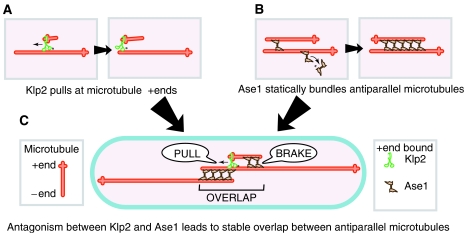Figure 1.
Model for the formation of stable bipolar microtubule arrays in fission yeast. (A) The minus-end-directed kinesin Klp2 (green) mediates antiparallel microtubule sliding by ‘pulling' short microtubules at their plus end. (B) The bundling protein Ase1 (brown) preferentially crosslinks antiparallel microtubules (red). (C) A short, newly nucleated microtubule is ‘pulled' by Klp2 to the bundle midzone. Increasing levels of Ase1 bind to the microtubule as it grows, gradually breaking its motion. The antagonism between Klp2 and Ase1 leads to the formation of a stable overlap between antiparallel microtubules in the cell (blue).

